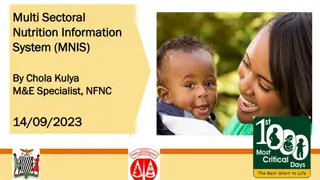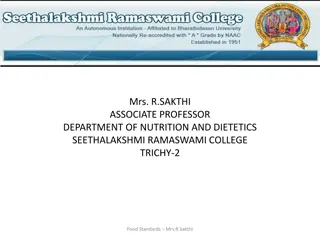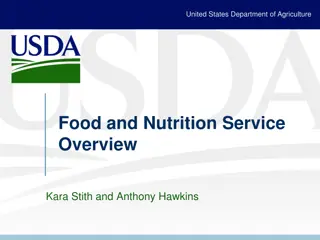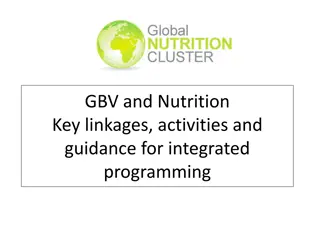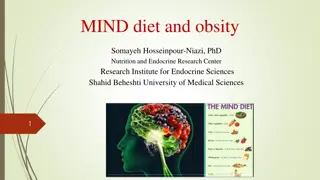BSc Food Science & Human Nutrition Programme Overview
This BSc Food Science & Human Nutrition programme at Maynooth University offers a comprehensive understanding of nutrition, biology, and chemistry as applied to food. With a focus on ingredients, production, products, and nutrition, students explore various aspects of food science including food saf
3 views • 12 slides
Enhancing Multisectoral Nutrition Coordination in Zambia
The Multisectoral Nutrition Information System (MNIS) presented at a LeNNS meeting in Lusaka highlights the importance of a multisectoral approach to address nutrition challenges in Zambia. The coordination structures, evidence, and recommendations emphasize the need for collaborative efforts, adequ
1 views • 37 slides
Community Health Workers' Contribution to Improved Nutrition in India
Community Health Workers play a vital role in enhancing nutrition outcomes in India by delivering high-impact practices, policies, and services at the community level. They help strengthen the foundation of nutrition programs, support maternal and child health, and promote healthy behaviors. By iden
0 views • 27 slides
Alina Michalska - Nutrition Specialist with UNICEF ESARO
Alina Michalska is a Nutrition Specialist with UNICEF Eastern and Southern Africa Regional Office (ESARO) based in Nairobi. She has a strong background in nutrition information systems and has worked on various projects to improve nutrition outcomes in different regions. With a Master's degree from
3 views • 22 slides
Understanding Nutritional Biochemistry: A Comprehensive Overview of Nutrition and Public Health
Nutrition, as defined by Robinson, explores the relationship between food and the human body's functioning. This course delves into key topics such as nutrition in pregnancy, childhood, and the elderly, as well as nutrition-related diseases. It emphasizes the importance of public health nutrition in
1 views • 7 slides
Multi-Sectoral Nutrition Information System (MNIS) Overview and Implementation Details
The Multi-Sectoral Nutrition Information System (MNIS) is a web-based platform used by the National Food and Nutrition Commission (NFNC) in Zambia to collect essential data for monitoring and decision-making in the nutrition sector. MNIS facilitates the gathering of functional information to support
1 views • 10 slides
Understanding Food Standards and Quality Assurance in Nutrition and Dietetics
Explore the realm of food standards, quality assurance, and safety protocols in the field of nutrition and dietetics. Learn about the regulations set by international bodies like the Codex Alimentarius Commission, as well as the specific standards for various food products such as milk, spices, star
2 views • 33 slides
Understanding the OECD Nutrition Policy Marker (NPM)
The OECD Nutrition Policy Marker (NPM) is a voluntary tool to identify donor investments with a nutrition objective. It helps mainstream nutrition in large-scale programs to improve outcomes and accountability. The NPM is applied at the project level to track investments and promote transparency in
1 views • 4 slides
Promoting Sustainable Local Foods for Nutrition Security in Nigeria
Food and nutrition insecurity in Nigeria is a pressing issue, prompting efforts to identify and promote locally available, nutritious foods. Stakeholder consultations in Sokoto, Kebbi, and Bauchi States highlighted the importance of staple crops like rice and millet, as well as bio-fortified crops.
0 views • 7 slides
Integrated Programming in Education and ECD: Enhancing Nutrition for Child Development
Explore the vital role of nutrition in education and Early Childhood Development (ECD) through integrated programming. Discover how good nutrition impacts children's physical development, health, learning abilities, and cognitive potential, ultimately influencing their educational success. Delve int
0 views • 11 slides
Overview of United States Department of Agriculture Food and Nutrition Service
The United States Department of Agriculture Food and Nutrition Service (FNS) works to provide food and nutrition education to those in need while supporting American agriculture. Their mission is to end hunger and improve nutrition in America. The Contracts Management Division (CMD) focuses on custo
1 views • 15 slides
Nutrition Advocacy in Humanitarian Contexts: GNC Advocacy Insights
Explore the strategic framework of Nutrition Cluster Advocacy, focusing on influencing policies for improving nutrition in emergencies. Learn about the Global Nutrition Commitments and key initiatives driving action to address malnutrition. Discover the GNC Advocacy Toolkit designed to support Nutri
1 views • 22 slides
Integrating GBV and Nutrition: Key Linkages and Strategies
Gender-based violence (GBV) and nutrition are interconnected, with GBV being a key driver of malnutrition. Integrating GBV into nutrition programs can improve response quality, mitigate malnutrition risks, and reach vulnerable populations effectively. This integration enhances the safety, accessibil
1 views • 17 slides
Understanding Food Standards and Quality Assurance in Nutrition and Dietetics
Explore the world of food standards and quality assurance with Mrs. R. Sakthi, an Associate Professor in the Department of Nutrition and Dietetics at Seethalakshmi Ramaswami College, Trichy. Learn about the regulations set by international bodies like the Codex Alimentarius Commission, the standards
1 views • 33 slides
Synergistic Role of Agriculture, Health, and Education in Nutrition Programs
Agriculture, health, and education play vital roles in nutrition program implementation. They are interconnected as agricultural practices impact health and nutrition outcomes. Agriculture is crucial for providing essential nutrition, while the health of individuals in agriculture affects productivi
2 views • 9 slides
Enhancing Pre-Service Nutrition Education for Nurses and Midwives in Ghana and Malawi
This project led by Alice Nkoroi focused on improving access and quality of nutrition services in Ghana and Malawi by enhancing pre-service nutrition education for frontline workers like nurses and midwives. The approach involved stakeholder consultation, defining core nutrition competencies, and co
1 views • 16 slides
Advocacy Strategy Development for Nutrition Cluster in Yemen
Amidst the challenges in Yemen, the Nutrition Cluster advocacy efforts focused on developing a comprehensive strategy to address nutritional needs of the affected population. The process involved partner identification, stakeholder engagement, strategy development, and implementation planning. The a
1 views • 9 slides
Nutrition Guidelines for Student Athletes
Learn about the nutritional needs of student athletes during winter conditioning, including the importance of lean proteins, whole grains, and fruits and vegetables. Discover basic nutrition rules and recommendations for meals, snacks, and pre- and post-workout fueling strategies. Take steps to supp
1 views • 13 slides
Nutrition Standards for School Food Sales
Proposed rules outline nutrition standards for all foods sold in schools to improve children's diets and health. The background emphasizes the importance of school nutrition programs, while the Healthy, Hunger-Free Kids Act grants authority to establish these standards. The proposal development cons
0 views • 31 slides
The MIND Diet for Managing Obesity
Explore the MIND diet, a nutrition plan to support weight management by emphasizing brain-healthy foods. Learn about recommended foods like leafy greens, berries, nuts, olive oil, whole grains, fish, beans, and poultry, along with foods to avoid. This diet promotes cognitive health while addressing
0 views • 13 slides
Integrating Nutrition Assessment and Counselling: Complementary Feeding Practices
This training course focuses on educating facility-based health providers on complementary feeding practices, emphasizing the importance of introducing solid foods along with breastfeeding at 6 months. The session covers topics like nutrition gaps in breast milk, optimal feeding principles, and util
0 views • 48 slides
Guidance for Complementary Feeding in Infants
After 6 months of age, breastfed infants may struggle to meet their nutrient needs from milk alone, necessitating the introduction of complementary foods. Implementing guiding principles can help ensure optimal nutrition and growth, including exclusive breastfeeding for the first 6 months, practicin
0 views • 18 slides
Understanding Healthy Nutrition Choices
Healthy foods include a variety of nutrient-rich options such as fruits, vegetables, whole grains, lean proteins, and low-fat dairy products. Carbohydrate foods can be found in sources like fruits, whole grains, and legumes. Protein-rich foods include meat, fish, poultry, dairy, and plant-based prot
0 views • 14 slides
Understanding Life Processes and Nutrition in Living Organisms
Life processes such as nutrition, respiration, transportation, and excretion are essential for living organisms to maintain life. This content delves into the various types of nutrition, including autotrophic and heterotrophic nutrition, with a focus on nutrition in plants, animals, and humans. It a
0 views • 20 slides
Understanding Glycaemic Index in Nutrition and Health
Glycaemic Index (GI) measures how carbohydrate-containing foods affect blood glucose levels. High GI foods raise blood glucose rapidly, while low GI foods release glucose gradually. Studies track impacts on blood glucose levels, insulin secretion, fat storage, and pancreatic function. High GI foods
0 views • 15 slides
Exploring Functional Foods for Health Benefits
Functional foods are dietary components consumed primarily for health reasons, providing benefits beyond basic nutrition. Types of functional foods include beans, berries, cruciferous vegetables, and cocoa products. Beans contain saponins that may help protect against cancers and lower cholesterol l
0 views • 24 slides
Effective Communication Strategies on GM Foods in Australia
Sasha Tait from FSANZ addresses the challenges faced in communicating with Australian consumers on GM foods due to values-based opposition. The country's transparency initiatives include public consultations and responses, increasing awareness. Social media presence allows direct communication. Usin
0 views • 10 slides
Maternal Nutrition Training: Integrating Assessment, Counselling, and Support
Maternal nutrition training session aims to educate health providers on the importance of maternal nutrition, causes and consequences of malnutrition, and strategies to break the malnutrition cycle. The training covers topics like defining maternal nutrition, understanding its significance throughou
0 views • 11 slides
Integrating Nutrition Assessment and Counselling for Clients with Active Tuberculosis
This training course emphasizes the critical relationship between nutrition and tuberculosis (TB), highlighting how undernutrition impacts TB infection and the implications of TB-HIV co-infections on nutritional status. Participants will learn about managing nutrition for individuals with active TB,
0 views • 29 slides
Importance of Nutrition and Balanced Diet for Health and Immunity
Leading a healthy lifestyle is crucial for improving immunity, which involves maintaining a balanced diet, getting enough sleep, regular exercise, personal and environmental hygiene, and staying optimistic. A balanced diet includes a variety of foods to ensure sufficient nutrients for a strong body
0 views • 23 slides
Improving Nutrition Goals for Children with CF
Optimizing growth and weight gain is crucial for children with cystic fibrosis (CF) to enhance health outcomes and survival. Behavioral barriers often hinder patients from achieving nutrition goals, but interventions combining nutrition and behavioral strategies have shown effectiveness. This approa
0 views • 27 slides
Sustainable Nutrition Multisectoral Commitments in Nigeria
Presentation at the 52nd Annual General Meeting of the Nutrition Society of Nigeria highlighting the importance of nurturing multisectoral commitments for sustainable nutrition in Nigeria. The Federal Government identified six priority areas of nutrition for investment in the National Multi-Sectoral
0 views • 9 slides
Fun Food Facts and Activities for Healthy Nutrition Education
Students engage in a creative MyPlate Profile activity to explore and learn about foods from the five food groups, enhancing their knowledge of nutrition and meal building. Additionally, fun and interesting facts about Pineapple, Peas, Yogurt, Oatmeal, and Tofu are presented with engaging descriptio
0 views • 6 slides
Responding to Child Nutrition Programs in Disasters
Learn how Child Nutrition Programs can effectively respond to disaster situations, including utilizing USDA Foods and programs like CACFP, SFSP, and D-SNAP. Discover methods, preparation steps, types of declarations, sources of USDA Foods, and inventory management strategies for efficient disaster r
0 views • 27 slides
Overview of LT Foods: Market Performance, Business Operations, and Future Potential
LT Foods, a prominent player in the packaged rice processing and export industry, boasts a strong brand portfolio including Daawat. With a focus on branded sales growth, reduction of debt, and product diversification, LT Foods is strategically positioning itself for future success. Recent developmen
0 views • 11 slides
Exploring the Fascinating World of Fermented Foods and Microorganisms
Unveil the intricate world of fermented foods, delving into the principles, microorganisms, and starter cultures involved. Discover the fine balance between spoilage and fermentation, the general properties and benefits of fermented foods, and the evolution of the fermented foods industry across tim
0 views • 16 slides
Exploring Types of Convenience and Processed Foods
Convenience and processed foods offer time-saving benefits, ease of storage, and convenience for meal preparation. They come in various forms such as canned/bottled, frozen, and dried foods, each with specific advantages and preparation methods. Understanding these types of foods can help in making
0 views • 17 slides
Understanding Nutrition in Animals: Types and Process
Nutrition in animals is vital for their survival, with various categories like herbivores, carnivores, and omnivores. Different modes of nutrition include filter feeding, deposit feeding, bulk feeding, fluid feeding, and suction feeding. The process of nutrition involves ingestion, digestion, absorp
0 views • 14 slides
Nutritional Therapy in the ICU: Enteral and Parenteral Nutrition Overview
Nutrition is crucial in ICU care to provide adequate calories and protein for patients. This involves enteral nutrition via tubes and parenteral nutrition through IV solutions. Enteral feeding should begin within 24-48 hours if the GI tract is functional, while parenteral nutrition includes dextrose
0 views • 13 slides
Optima Nutrition: Maximizing Efficiency of Nutrition Investments in Tajikistan
Preliminary analysis on the allocative efficiency of nutrition investments in Tajikistan reveals the potential impact of Optima Nutrition in optimizing resource allocation for various interventions. The tool aims to enhance the cost-effectiveness and effectiveness of public health investments in nut
0 views • 23 slides





